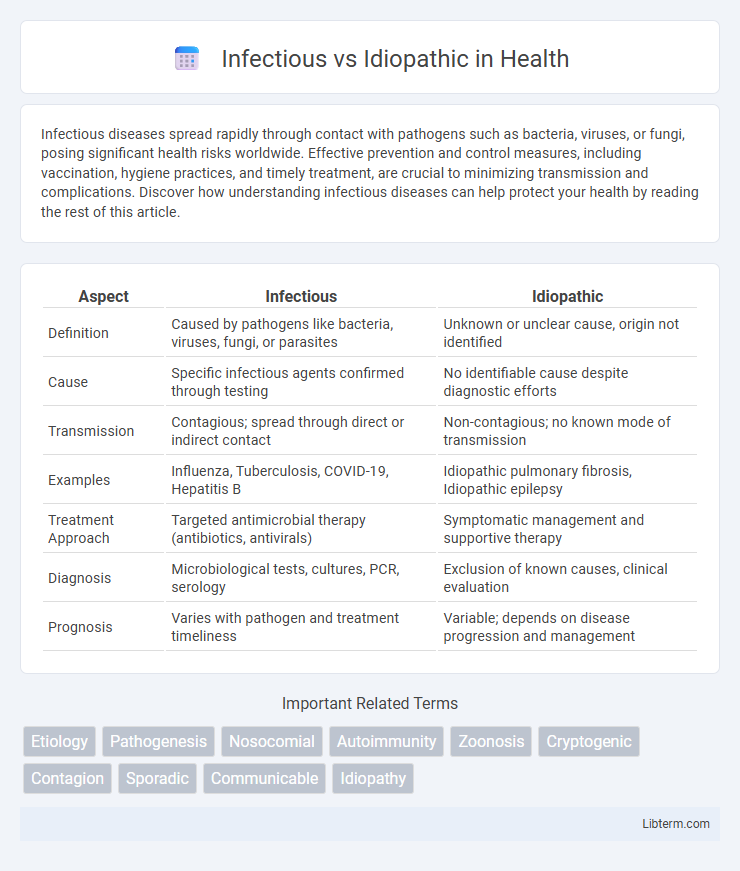Infectious diseases spread rapidly through contact with pathogens such as bacteria, viruses, or fungi, posing significant health risks worldwide. Effective prevention and control measures, including vaccination, hygiene practices, and timely treatment, are crucial to minimizing transmission and complications. Discover how understanding infectious diseases can help protect your health by reading the rest of this article.
Table of Comparison
| Aspect | Infectious | Idiopathic |
|---|---|---|
| Definition | Caused by pathogens like bacteria, viruses, fungi, or parasites | Unknown or unclear cause, origin not identified |
| Cause | Specific infectious agents confirmed through testing | No identifiable cause despite diagnostic efforts |
| Transmission | Contagious; spread through direct or indirect contact | Non-contagious; no known mode of transmission |
| Examples | Influenza, Tuberculosis, COVID-19, Hepatitis B | Idiopathic pulmonary fibrosis, Idiopathic epilepsy |
| Treatment Approach | Targeted antimicrobial therapy (antibiotics, antivirals) | Symptomatic management and supportive therapy |
| Diagnosis | Microbiological tests, cultures, PCR, serology | Exclusion of known causes, clinical evaluation |
| Prognosis | Varies with pathogen and treatment timeliness | Variable; depends on disease progression and management |
Introduction to Infectious and Idiopathic Diseases
Infectious diseases result from pathogenic microorganisms such as bacteria, viruses, fungi, or parasites invading the body and triggering immune responses. Idiopathic diseases lack a known cause despite thorough investigation, often diagnosed by excluding other conditions. Understanding the distinction aids in targeted treatment and effective disease management strategies.
Defining Infectious Diseases
Infectious diseases are caused by pathogenic microorganisms such as bacteria, viruses, fungi, or parasites that invade the body and trigger an immune response. These diseases can be transmitted directly or indirectly between hosts, often resulting in outbreaks or epidemics. Differentiating infectious diseases from idiopathic conditions is critical, as idiopathic diseases have unknown causes and do not stem from infectious agents.
Understanding Idiopathic Conditions
Idiopathic conditions refer to diseases or disorders with unknown causes despite thorough medical evaluation, contrasting with infectious diseases caused by identifiable pathogens. Understanding idiopathic conditions involves exploring genetic factors, environmental influences, and complex pathophysiological mechanisms that evade current diagnostic techniques. Advances in molecular biology and imaging technologies aim to uncover underlying factors, improving diagnosis and targeted treatment strategies for idiopathic cases.
Key Differences Between Infectious and Idiopathic Disorders
Infectious disorders are caused by pathogens such as bacteria, viruses, fungi, or parasites, with identifiable agents triggering the disease. Idiopathic disorders lack a known cause despite extensive medical evaluation, making diagnosis and treatment more challenging. Understanding the distinction aids in targeted therapies, where infectious conditions often require antimicrobial treatment while idiopathic disorders may rely on symptom management and supportive care.
Common Examples of Infectious Diseases
Infectious diseases are caused by pathogens such as bacteria, viruses, fungi, or parasites, with common examples including influenza, tuberculosis, and HIV/AIDS. These diseases are often transmitted through direct contact, airborne droplets, or contaminated surfaces, leading to widespread outbreaks and significant public health challenges. Unlike idiopathic conditions, which have unknown origins, infectious diseases have identifiable causative agents enabling targeted treatments and preventive measures like vaccines.
Common Examples of Idiopathic Diseases
Idiopathic diseases, characterized by unknown causes, include common examples such as idiopathic pulmonary fibrosis, idiopathic thrombocytopenic purpura, and idiopathic epilepsy. These conditions contrast with infectious diseases, which result from identifiable pathogens like bacteria, viruses, or fungi. Understanding idiopathic diseases requires advanced diagnostic techniques and extensive clinical research due to their unclear etiology.
Diagnosis: Infectious vs Idiopathic
Diagnosis of infectious conditions involves identifying pathogens through laboratory tests such as blood cultures, PCR, or serology, which detect bacteria, viruses, or fungi causing the illness. Idiopathic diagnoses rely on excluding known infectious, autoimmune, or genetic causes by comprehensive clinical evaluation and advanced imaging or biopsy when necessary. Accurate differentiation between infectious and idiopathic origins guides targeted treatment and prevents unnecessary antibiotic use.
Treatment Approaches: Infectious vs Idiopathic
Treatment approaches for infectious conditions primarily involve targeted antimicrobial therapies such as antibiotics, antivirals, or antifungals to eliminate the causative pathogen. In contrast, idiopathic conditions require symptom management and supportive care due to the unknown etiology, often involving corticosteroids, immunosuppressants, or physical therapy to control inflammation and improve function. Accurate diagnosis differentiates infectious from idiopathic causes, guiding effective therapeutic strategies and preventing unnecessary antimicrobial use.
Prevention Strategies for Each Type
Infectious diseases require prevention strategies focused on hygiene measures, vaccination, and controlling exposure to pathogens through sanitation and quarantine protocols. Idiopathic conditions, lacking identifiable causes, emphasize prevention via regular health screenings, lifestyle modifications, and managing risk factors such as diet, exercise, and environmental exposures. Targeted prevention enhances disease control by addressing the specific nature of infectious agents or the unknown origins of idiopathic disorders.
Prognosis and Patient Outcomes
Infectious diseases often have a more predictable prognosis due to identifiable pathogens and targeted treatments, leading to generally favorable patient outcomes with timely intervention. Idiopathic conditions, lacking a known cause, present challenges in prognosis and management, often resulting in variable patient outcomes and prolonged uncertainty. Early diagnosis and tailored treatment strategies are critical in improving recovery and quality of life across both infectious and idiopathic cases.
Infectious Infographic

 libterm.com
libterm.com